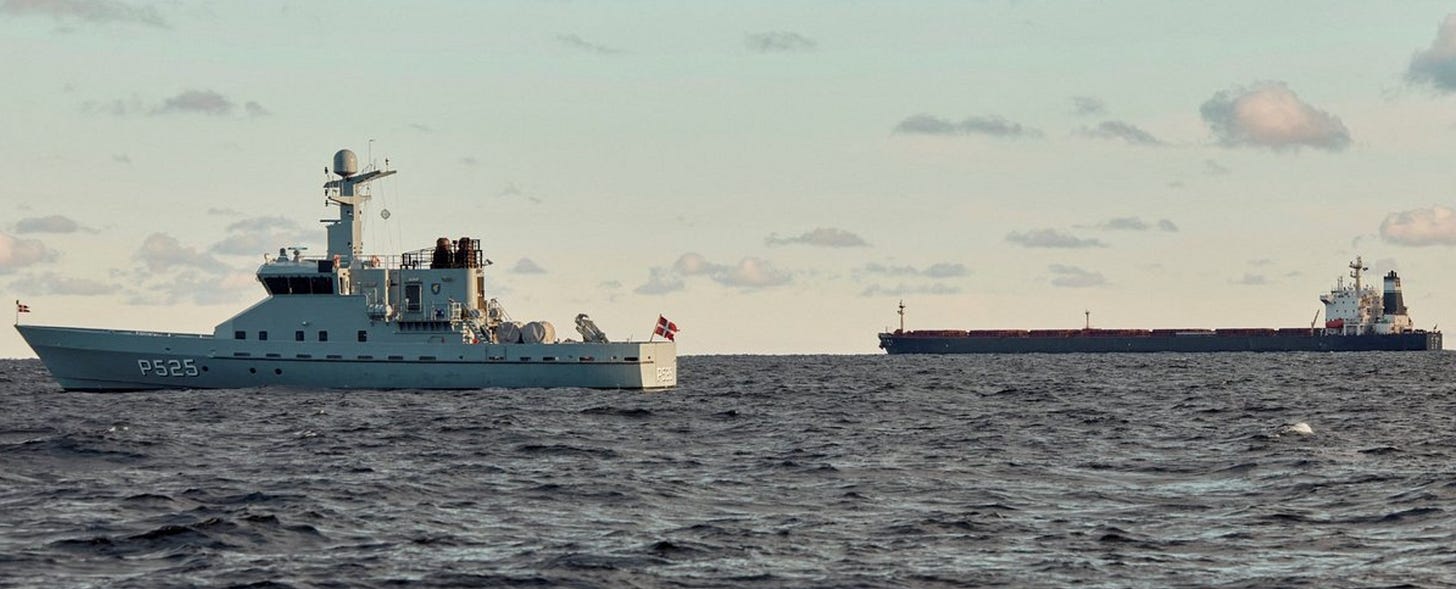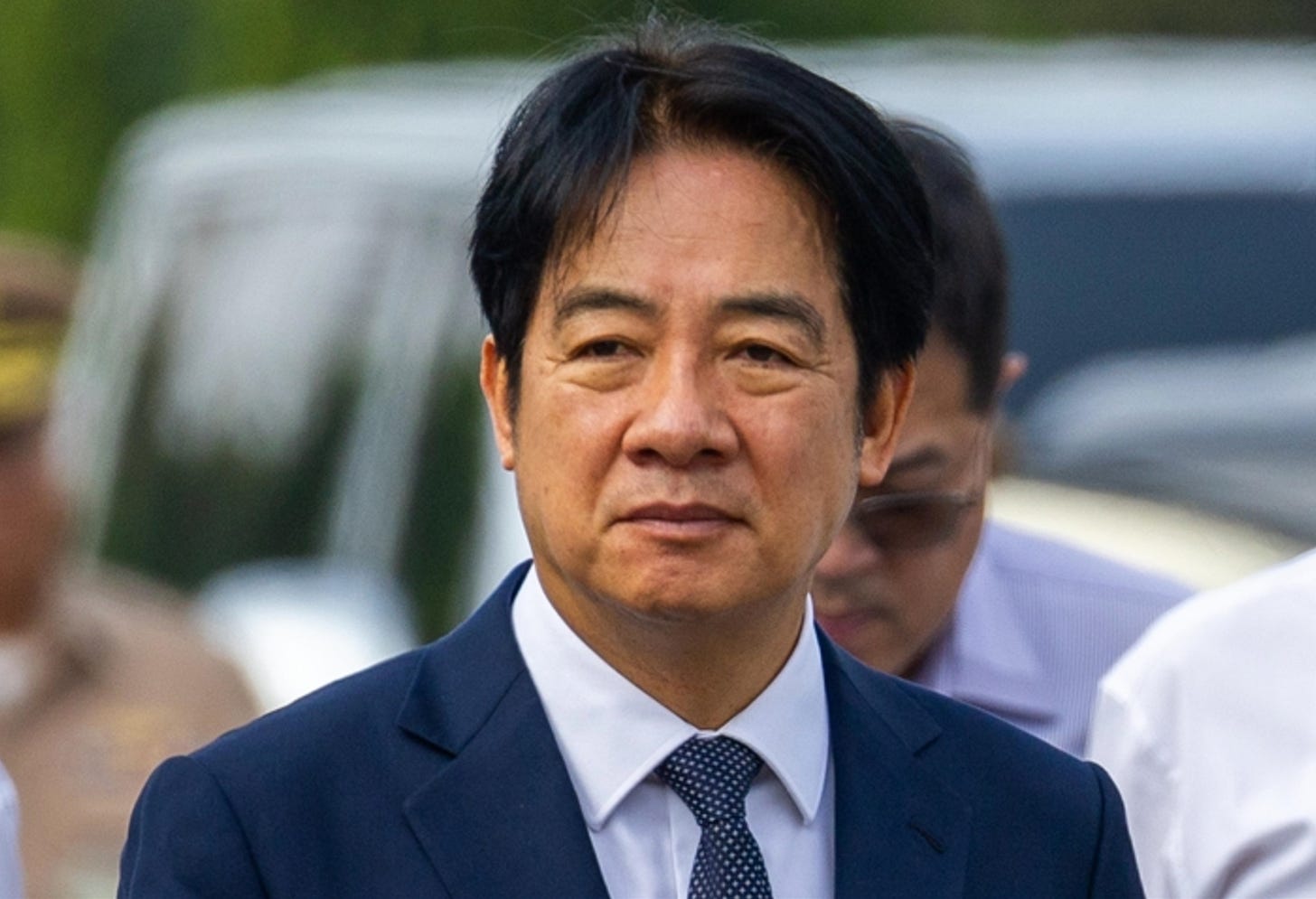Briefly - China and the Changing World Order no.17
Chinese vessel "accidentally" knocks out Baltic cables; Taiwan's President jets out on diplomatic tour and annoys Beijing
Hello and welcome back to What China Wants
Today I am back with two more reports+analysis from our (AI-powered) Adarga Briefly: China in the changing world order.
Both stories are very important.
Many intelligence officials will likely view the Baltic cable incident as a continuation of Chinese greyzone activities, but this time in support of Russia rather than in their normal South China Sea/East China Sea habitat. We already have Asia and Europe coming together in Ukraine through the deployment of North Korean forces in Russia, but China adding even its unofficial weight to undermining European security would be a heady blow for the West.
The President Lai story is also noteworthy because it is normally times like this – when a Taiwanese President is trying to talk to the West – that China starts its sabre-rattling. We are outside of the window of operations for blockading Taiwan (the Strait is too rough in winter) but still we might expect some kind of activity emanating from Beijing.
I’ll be back on Saturday with more research-related insights.
Thanks for reading.
Sam
Security | Subsea cable sabotage
On 17-18 November two subsea cables in the Baltic Sea, one linking Finland and Germany and the other connecting Sweden and Lithuania, were damaged within less than 24 hours. Initial statements indicated the incidents were likely acts of sabotage rather than accidents. German Defence Minister Boris Pistorius stated, “No one believes that these cables were cut accidentally”. Furthermore, in its statement, Cinia, the Finnish telecoms and cyber security firm responsible for the C-Lion1 – one of the severed cables – articulated its assessment that the cable was likely severed ‘by an outside force’.
Analysis: The Baltic Sea is a strategic chokepoint for Europe, hosting key energy pipelines, communication cables, and trade routes; the cables affected by this incident are crucial for both internet connectivity and energy supplies across the region. Consequently, these events have prompted discussions around enhancing the protection of undersea cables and critical digital networks, highlighting vulnerabilities associated with existing infrastructures. The incident also underscores the limitations of international maritime law in responding to hybrid threats. The inability to immediately board and inspect the Yi Peng 3 due to jurisdictional constraints highlights the legal gaps adversaries could exploit to carry out grey-zone operations in the region.

With Finland and Sweden – both directly affected by the incident – recently strengthening their ties to NATO, the region has increasingly become a theatre for global power politics to play out. In September, US officials indicated there had been increased Russian military activity around undersea cables in the Baltic Sea, which raised concerns at the time about potential threats to European critical digital infrastructure. Likewise, NATO had enhanced its protection for European maritime infrastructure that transports much of energy supply and undergirds global internet traffic in recent months.
Intentional damage to cables has been observed in previous incidents and is highly likely part of hybrid warfare tactics used against European nations. In this sense, damage to these subsea cables not only highlights geopolitical tensions but also serves as an example of how low-tech disruptions can be weaponised within hybrid warfare strategies. Despite widespread concerns about intentional sabotage, most damage to undersea cables globally —estimated at 100-150 incidents annually — is caused by anchors and fishing equipment. This underscores the susceptibility of critical infrastructure to everyday maritime activity, but also illustrates the opportunity for this to be exploited by states as a cover for deliberate actions.
From a hybrid warfare perspective, leveraging such low-tech means presents a low-cost, low-risk method to destabilise opponents while maintaining plausible deniability. Dragging an anchor or deploying fishing equipment near vital subsea cables could mimic routine maritime operations, complicating attribution and response efforts of those affected. Unlike advanced cyberattacks or missile strikes, these methods avoid immediate detection and allow state or non-state actors to test the resilience of an adversary’s infrastructure while reducing the risk of provoking an overt military retaliation.
China's potential involvement in the cable damage, while still under investigation, could reflect its broader strategic goals. There is a realistic possibility that such an act of sabotage is designed to test Europe's capacity to respond to hybrid warfare tactics targeting critical infrastructure. Disrupting these cables not only hampers communication but also signals vulnerabilities that adversaries could then exploit in future. Furthermore, the involvement of a vessel departing from Russia — a country already accused in multiple sabotage cases and recent foiled plots — could signal the realistic possibility of potential alignment between Beijing and Moscow in testing and undermining European security and resilience.
This incident is emblematic of a broader trend of increasing strategic competition in the Baltic Sea, which is becoming a focal point of global power struggles. With Finland and Sweden’s recent accession to NATO, the Baltic has gained even greater prominence as a geopolitical theatre. If confirmed as deliberate sabotage, this event would mark a significant escalation in hybrid warfare tactics targeting Europe. Even if the damage was caused unintentionally, it highlights the fragile nature of subsea cable networks that form the backbone of global communication and data transfer. The deliberate or accidental nature of these cable damages will likely be secondary to their symbolic and practical importance: they reveal glaring vulnerabilities in Europe’s infrastructure security and reinforce concerns over the potential escalation of hybrid warfare tactics.
Given the proximity of Russia to the Baltic and the increasing involvement of China, tensions in the region are likely to rise. By intensifying fears of further disruptions targeting energy supplies, data connectivity, or trade routes, it is highly likely this event will lead to heightened military and surveillance activities by NATO and individual European states, which in turn could provoke reciprocal actions from Russia and potentially China, increasing the risk of miscalculation or confrontation in an already volatile region. From a legal perspective, there is a realistic possibility that European nations may push for legal reforms that enable faster responses to suspicious activities in exclusive economic zones (EEZs), potentially including provisions for pre-emptive inspections of vessels deemed to be a threat.
Politics | Taiwanese President’s Diplomatic Tour
On 28 November it was reported that Taiwanese President William Lai Ching-te is set to embark on his first overseas trip since taking office, visiting the Marshall Islands, Tuvalu, and Palau from 30 November to 6 December 2024. This will be Lai's first overseas trip since taking office in May 2024. During the trip, his itinerary includes a two-night stopover Hawaii and a visit to the U.S. territory of Guam, where he is expected to have meetings with think tanks and local Taiwanese communities.
The announcement of the trip as well has drawn criticism from Beijing, which opposes any actions perceived as supporting Taiwan's independence. Publicly Chinese officials have also condemned Lai's planned stopovers, categorising them as "separatist actions" and have warned against the implications of official interactions between the U.S. and Taiwan.
Analysis:President Lai’s first overseas trip since taking office is a significant move by Taiwan to bolster its international standing; visits to the Marshall Islands, Tuvalu and Palau almost certainly reflect Taiwan’s strategic aim to solidify ties with its 12 remaining diplomatic allies, three of which are located in the Pacific. The trip also likely exemplifies Taiwan’s resilience against Beijing’s sustained efforts to isolate it diplomatically. China has, in recent years, intensified its outreach in the Pacific region through financial aid, infrastructure projects, and security agreements, and in so doing has successfully persuaded countries such as Kiribati and the Solomon Islands to sever ties with Taiwan and align with its ‘One China’ principle. Therefore, Lai’s visit can be interpreted as both a defensive measure to preserve Taiwan’s existing alliances and a proactive diplomatic offensive to counter China’s growing influence in the strategically important region.

China’s reaction to the President’s tour reflects its growing frustration over Taiwan’s diplomatic engagements and its deep-seated opposition to any actions perceived as promoting Taiwan’s independence. Beijing almost certainly views Taiwan’s outreach to Pacific Island nations as a direct challenge to its “One China” principle, and its criticisms highlight broader concerns about Taiwan’s continued diplomatic presence in the Pacific, where Beijing has sought to position itself as the dominant power. Beijing’s irritation partially also stems from those efforts to erode Taiwan’s alliances, and visits like Lai’s counteract China’s narrative of Taiwan’s diminishing international relevance.
The inclusion of stopovers in Hawaii and Guam adds a layer of geopolitical complexity; the rhetoric from Beijing has been particularly sharp regarding Lai’s scheduled visits to Guam and Hawaii, which reflects heightened tensions between the US and China, as well as China’s ongoing frustration at American arms sales to Taiwan. Although these stopovers are consistent with the American approach of strategic ambiguity towards Taiwan, Beijing views these interactions as undermining its sovereignty claims over Taiwan and encouraging other nations to deepen ties with Taipei. Mao Ning’s and Wu Qian’s condemnations of the trip as an attempt to promote separatism is almost certainly reflective of China’s zero-tolerance stance on any actions that could bolster Taiwan’s legitimacy on the world stage.
Mao Ning’s decision to decline comment on the Reuters report regarding potential Chinese military drills near Taiwan is indicative of Beijing’s strict adherence to its “One China” principle, which frames Taiwan as an internal matter rather than an issue warranting public international discourse. By avoiding an explicit acknowledgment of potential military activity, Mao’s response underscores Beijing’s consistent narrative that Taiwan is a domestic issue under its jurisdiction, thus making any foreign involvement or scrutiny illegitimate from China’s perspective. This aligns with China’s broader diplomatic approach of deflecting external inquiries about Taiwan-related policies, reinforcing its stance that the island is a non-negotiable part of Chinese sovereignty. Mao’s silence on the report, therefore, reflects less about the specifics of military strategy and more about maintaining the position that Taiwan’s affairs should not be open to international commentary or intervention, even as Beijing engages in actions designed to project its power and assert its claims over the island.
It is highly likely there will be a projection of Chinese military power in the form of military drills as a response to Lai’s tour, either concurrently with the visit or shortly after. This would be consistent with past precedent as previous Taiwanese leaders have made stopovers in the U.S. during their overseas trips, and prompted strong responses from Beijing. For example Lai's predecessor, Tsai Ing-wen, similarly transited through U.S. territories during her visits, which led to military drills around the island by China in response. This response reflects Beijing’s broader strategy of using both coercion and rhetoric to isolate Taiwan while signalling its determination to counter growing US-Taiwan cooperation.



